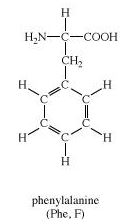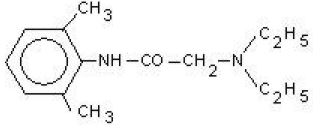
Concept explainers
Interpretation:
The
Concept introduction:
Phenylalanine is an α-amino acid with the formula Phenylalanine is an α-amino acid with the formula C9H11NO2.
Here, the benzyl group is substituted for the methyl group of alanine, or a phenyl group in place of terminal hydrogen of alanine.
Lidocaine, also known as xylocaine and lignocaine, is a medication used to numb tissue in a specific area.
Formula: C14H22N2O
Answer to Problem 19VC

Here, Primary

Here, amide group is present as functional group in this molecule.
Explanation of Solution
From the structure of phenylalanine, it is quite evident that the terminal hydrogen of alanine is replaced by a benzyl or phenyl group.
In this way, carbon forms a covalent bond with another carbon atom or other atoms.
-NH2 group and –COOH groups are present in Phenylalanine.
-NH and C=O (Amide) groups are present as functional groups in Lidocaine.
Want to see more full solutions like this?
Chapter 3 Solutions
Organic Chemistry (Instructor's)
- There are several isomeric alcohols and ethers of molecular formula C5H12O. Propose a structure for the isomer. Isomer B: δ = 0.92 (t, 7.8 Hz, 3 H), 1.20 (s, 6H), 1.49 (q, 7.8 Hz, 2H), 1.85 (s, 1H) ppmarrow_forwardName the following compounds, i just need part N, V, and O. Thank you!arrow_forwardPropanal, an aldehyde with the formula CH3CH2CHO, and n-propylamine have identical molecular weights (59 amu) and identical boiling points (49 C) Which molecule do you expect to be more polar and why?arrow_forward
- D-Pseudoephedrine, a decongestant that shrinks blood vessels in the nasal passages (treating stuffy nose), has the structure shown below. 1. What is the absolute configuration (R/S) of the carbon with – OH? 2. What is the absolute configuration (R/S) of the carbon with – CH3 3. Draw an enantiomer of this molecule: 4. Draw a distereomer of this moleculearrow_forward16-17 Propylamine (bp 48°C), ethylmethylamine (bp 37°C), and trimethylamine (bp 3°C) are constitutional isomers with the molecular formula C3HgN. Account for the fact that trimethylamine has the lowest boiling point of the three and propylamine has the highest.arrow_forwardThe following sequence of steps converts (R)-2-octanol to (S)-2-octanol. Propose structural formulas for intermediates A and B, specify the configuration of each, and account for the inversion of configuration in this sequence.arrow_forward
- All but one of these structures contribute to the resonance hybrid of C2H5ON. Which of these structures does not contribute to the resonance hybrid? Select the single best answer.arrow_forwardUnknown B: Soluble in water Bubbles upon contact with 5% NaHCO3 and forms a homogenous solutionWhat functional group is most likely present in the sample?arrow_forwardRank the following groups in order of decreasing priority. −Cl, −CH3, −SH, −OHarrow_forward
- A2 1. An alkyne with molecular formula C5H10 2. A ketone with molecular formula C4H8O 3. A ketone with molecular formula C3H8O 4. An alkene with molecular formula C5H8 5. An alkene with molecular formula C5H10 6. An aldehyde with molecular formula C2H4O 7. An aldehyde with molecular formula CH4O 8. A saturated hydrocarbon with molecular formula C6H14arrow_forwardFormula: C9H10O3 . Determine the structure of the compound given the data shown in the pictures. Explain how you arrived at the answer.arrow_forwardWhich statement best describes the following pair of compounds? C4H6 and C6H12 A.) Circulated functional groups do not show absorption in the infrared spectrum because they have the same mass B.) The reduced mass of both compounds is the same so they do not absorb IR (infrared) energy. C.) The functional group specified in both compounds does not undergo changes in the dipole moment due to symmetry D.) Both represent an absorption band around 2000 cm ^ -1arrow_forward

 Organic ChemistryChemistryISBN:9781305580350Author:William H. Brown, Brent L. Iverson, Eric Anslyn, Christopher S. FootePublisher:Cengage Learning
Organic ChemistryChemistryISBN:9781305580350Author:William H. Brown, Brent L. Iverson, Eric Anslyn, Christopher S. FootePublisher:Cengage Learning Introduction to General, Organic and BiochemistryChemistryISBN:9781285869759Author:Frederick A. Bettelheim, William H. Brown, Mary K. Campbell, Shawn O. Farrell, Omar TorresPublisher:Cengage Learning
Introduction to General, Organic and BiochemistryChemistryISBN:9781285869759Author:Frederick A. Bettelheim, William H. Brown, Mary K. Campbell, Shawn O. Farrell, Omar TorresPublisher:Cengage Learning


